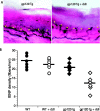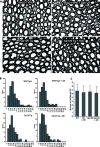Establishment of a rodent model of HIV-associated sensory neuropathy
- PMID: 17021185
- PMCID: PMC6674617
- DOI: 10.1523/JNEUROSCI.3135-06.2006
Establishment of a rodent model of HIV-associated sensory neuropathy
Abstract
Human immunodeficiency virus (HIV)-associated sensory neuropathy (SN) is the most common neurological complication of HIV infection in the current highly active antiretroviral therapy era. The painful sensory neuropathy is associated with the use of dideoxynucleoside antiretrovirals, and its development limits the choice of antiretroviral drugs in affected patients. There are presently no effective therapies for HIV-SN, and moreover there has been no robust animal model of HIV-SN in which candidate therapeutic agents can be tested. In this paper, we show that we have established a rodent model of HIV-SN by oral administration of a dideoxynucleoside drug, didanosine, to transgenic mice expressing the HIV coat protein gp120 under a GFAP promoter. The neuropathy in these rodents is characterized by distal degeneration of unmyelinated sensory axons, similar to the "dying back" pattern of C-fiber loss seen in patients with HIV-SN. This model will be useful in examining mechanisms of distal axonal degeneration and testing potential neuroprotective compounds that may prevent development of the sensory neuropathy.
Figures




Similar articles
-
Erythropoietin is neuroprotective in models of HIV sensory neuropathy.Neurosci Lett. 2004 Nov 23;371(2-3):102-5. doi: 10.1016/j.neulet.2004.08.080. Neurosci Lett. 2004. PMID: 15519737
-
Diagnosis and management of HIV-associated neuropathy.Neurol Clin. 2008 Aug;26(3):821-32, x. doi: 10.1016/j.ncl.2008.04.001. Neurol Clin. 2008. PMID: 18657728 Review.
-
Continued high prevalence and adverse clinical impact of human immunodeficiency virus-associated sensory neuropathy in the era of combination antiretroviral therapy: the CHARTER Study.Arch Neurol. 2010 May;67(5):552-8. doi: 10.1001/archneurol.2010.76. Arch Neurol. 2010. PMID: 20457954 Free PMC article.
-
Pathogenesis of HIV-associated sensory neuropathy: evidence from in vivo and in vitro experimental models.J Peripher Nerv Syst. 2012 Mar;17(1):19-31. doi: 10.1111/j.1529-8027.2012.00373.x. J Peripher Nerv Syst. 2012. PMID: 22462664 Review.
-
HIV neuropathy: insights in the pathology of HIV peripheral nerve disease.J Peripher Nerv Syst. 2001 Mar;6(1):21-7. doi: 10.1046/j.1529-8027.2001.006001021.x. J Peripher Nerv Syst. 2001. PMID: 11293804 Review.
Cited by
-
HIV Glycoprotein Gp120 Impairs Fast Axonal Transport by Activating Tak1 Signaling Pathways.ASN Neuro. 2016 Nov 20;8(6):1759091416679073. doi: 10.1177/1759091416679073. Print 2016 Dec. ASN Neuro. 2016. PMID: 27872270 Free PMC article.
-
Schwann cells promote post-traumatic nerve inflammation and neuropathic pain through MHC class II.Sci Rep. 2017 Oct 2;7(1):12518. doi: 10.1038/s41598-017-12744-2. Sci Rep. 2017. PMID: 28970572 Free PMC article.
-
Cytokine and chemokine regulation of sensory neuron function.Handb Exp Pharmacol. 2009;(194):417-49. doi: 10.1007/978-3-540-79090-7_12. Handb Exp Pharmacol. 2009. PMID: 19655114 Free PMC article. Review.
-
Wnt signaling in the pathogenesis of human HIV-associated pain syndromes.J Neuroimmune Pharmacol. 2013 Sep;8(4):956-64. doi: 10.1007/s11481-013-9474-4. Epub 2013 Jun 5. J Neuroimmune Pharmacol. 2013. PMID: 23737037 Free PMC article.
-
Pharmacological, behavioural and mechanistic analysis of HIV-1 gp120 induced painful neuropathy.Pain. 2007 Dec 15;133(1-3):47-63. doi: 10.1016/j.pain.2007.02.015. Epub 2007 Apr 12. Pain. 2007. PMID: 17433546 Free PMC article.
References
-
- Anderson TD, Davidovich A, Feldman D, Sprinkle TJ, Arezzo J, Brosnan C, Calderon RO, Fossom LH, DeVries JT, DeVries GH. Mitochondrial schwannopathy and peripheral myelinopathy in a rabbit model of dideoxycytidine neurotoxicity. Lab Invest. 1994;70:724–739. - PubMed
-
- Apostolski S, McAlarney T, Quattrini A, Levison SW, Rosoklija G, Lugaressi A, Corbo M, Sadiq SA, Lederman S, Hays AP. The gp120 glycoprotein of human immunodeficiency virus type 1 binds to sensory ganglion neurons. Ann Neurol. 1993;34:855–863. - PubMed
-
- Cherry CL, Gahan ME, McArthur JC, Lewin SR, Hoy JF, Wesselingh SL. Exposure to dideoxynucleosides is reflected in lowered mitochondrial DNA in subcutaneous fat. J Acquir Immune Defic Syndr. 2002;30:271–277. - PubMed
-
- Cooney DA, Dalal M, Mitsuya H, McMahon JB, Nadkarni M, Balzarini J, Broder S, Johns DG. Initial studies on the cellular pharmacology of 2′,3-dideoxycytidine, an inhibitor of HTLV-III infectivity. Biochem Pharmacol. 1986;35:2065–2068. - PubMed
Publication types
MeSH terms
Substances
Grants and funding
LinkOut - more resources
Full Text Sources
Medical
Molecular Biology Databases
Miscellaneous
